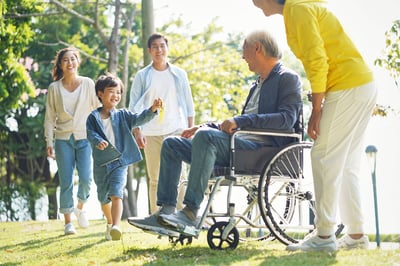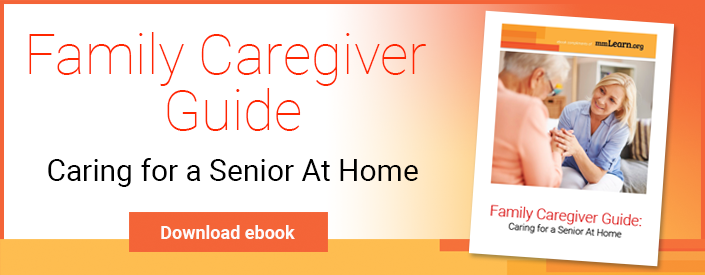 Loneliness is quite literally a health hazard for seniors. It affects an estimated one-third of the population of older Americans and causes a 29% increase in premature mortality.
Loneliness is quite literally a health hazard for seniors. It affects an estimated one-third of the population of older Americans and causes a 29% increase in premature mortality.
Loneliness is the difference between what we desire and what we actually experience, and it can be a problem, even when a person is surrounded by others.
Loneliness is more than a passing phase or a bad mood. According to an article in Psychology Today, “Loneliness is not only painful emotionally but it can have a devastating impact on one’s long-term psychological and physical health. Loneliness predisposes us to depression and increases our risk of Alzheimer’s disease, it suppresses our immune system functioning, it stresses our cardiovascular systems, and when chronic, it affects our very longevity.”
In this mmlearn video, Dr. Thomas Weiss, a geriatric psychologist, explores the risk factors and health effects of loneliness. He also describes the biological effects of loneliness and options for treating it.
What Is Loneliness?
Humans are social creatures who are built to live and work together in communities. When someone is connected with people they love and trust, they thrive. Loneliness steals that away, making someone feel disconnected.
Early in the presentation, Dr. Weiss shares a Jewish proverb, “Loneliness breaks the spirit,” which describes the fundamental pain of loneliness.
Loneliness can be described as the discrepancy between a person's desired and actual social relationship. It is a sense of being emotionally disconnected from others.
Have you ever heard the phrase “lonely in a crowd”? When we are lonely, we can perceive ourselves to be socially isolated even when we are among other people. And it can cause us to be irritable, depressed, and self-centered, says Dr. Weiss.
Loneliness has serious consequences for health and wellness—and people of every age, race, ethnicity, and ability can experience it.
Dr. Weiss emphasizes that loneliness is not the same as social isolation, or lack of contact with others.
Measuring Loneliness
We don’t have to guess whether someone is lonely or not. Social scientists have developed tools to determine whether someone is experiencing loneliness. The gold standard, according to Dr. Weiss, is the UCLA Loneliness Scale that was developed in 1994. For decades before that, the main measure was the Belcher Extended Loneliness Scale.
Dr. Weiss also shares an effective three-question survey that is used to measure loneliness.
-
How often do you feel you lack companionship?
-
How often do you feel left out?
-
How often do you feel isolated from others?
How Common Is Loneliness?
Dr. Weiss shares statistical data on loneliness that suggests that it is an epidemic, especially for our elders.
-
20% of adults older than 65 report feeling lonely “much of the previous week.”
-
32% of adults older than 55 “feel lonely at any given time.”
-
Rates of loneliness have doubled since the 1980s.
-
200,000 older people have not had a conversation with friends or family for a month.
In this age of technological advances, these skyrocketing rates of loneliness are shocking.
How can caregivers and families help combat loneliness in our loved ones and in the population of elders?
Risk Factors
Loneliness is an equal opportunity affliction that affects people of every education level, income level, gender, ethnicity, and ability. But there are some factors that contribute to loneliness: delayed age of marriage, increase in dual-career families and single-residence households, and reduced fertility rates.
And almost 3.9 million people agree that the TV is their main form of social connectedness.
As a society, we can do better.
Health Effects of Loneliness
How can loneliness lead to early death? The effects of loneliness on our health are equivalent to smoking 15 cigarettes a day; it is more unhealthy for us than air pollution, obesity, or alcoholism.
Physical Effects
We have a pretty good idea of how loneliness affects our spirit, but not everyone is aware of the physical effects, such as:
-
Increased vascular resistance
-
Elevated systolic blood pressure
-
Less restorative sleep
-
Diminished immunity
-
Increased HPA activity (making people hypervigilant to threats that don’t exist)
-
Reduced anti-inflammatory activity
-
Abnormal circulating white blood cells
Studies have also shown that heart surgery patients who have strong social support networks and spiritual practices have one-seventh the mortality rate of those who don’t.
Mental Effects
It’s less surprising but no less distressing that loneliness takes a serious toll on the mental health of seniors. Loneliness leads to:
-
An increased risk of cognitive decline and progression of Alzheimer’s disease
-
Decreased executive functioning
-
Hypervigilance for social threats
-
Increased depression, suicidal ideation, and suicidal behavior
Biology of Loneliness
Today’s technology allows scientists to observe that people’s brains work differently when they are experiencing chronic loneliness. Functional magnetic resonance imaging (fMRI) of the brains of people who meet the criteria for loneliness on the UCLA scale showed
-
Decreased activation in the reward circuit
-
Increased attention to “negative social cues”
-
Increased activation of the fear circuit
-
Reduced activity in the prefrontal cortex that affects control/restraint
Treatment Options for Loneliness
It is important to recognize loneliness and to avoid it in order to help someone reconnect with others. Dr. Weiss shares some intuitive advice for treating loneliness. He suggests the following:
-
Improving social skills by creating regular opportunities to share positive moments of connection.
-
Enhancing social support by helping seniors get out in the community for meaningful activities.
-
Increasing opportunities for social contact. Programs like Meals on Wheels increase opportunities for social interaction that help people feel loved and connected.
-
Cognitive behavioral therapy (CBT) is a form of therapy that has been scientifically proven to help people reverse the negative loops that feed loneliness.
Advice for Caregivers
Remember that helping someone who suffers from loneliness doesn’t need to be fancy. We can help by encouraging and facilitating involvement in religions or spiritual communities, service organizations, charities, adult education, or social clubs.
On an individual basis, make your support available as a confidant. Put the phone down and spend time just listening.
Tips for Managing Loneliness
Remember that holidays can sometimes be challenging for seniors, especially if they are grieving someone who has passed away, or feeling sad about changes in their mind or body. This mmlearn post on holiday loneliness explores simple strategies for connection.
Four Tips for Managing Senior Loneliness
-
Schedule regular activities. Arrange for a change of scenery—a stroll around a botanical garden, or a shopping excursion, or a lunch date. And encourage others to reach out to older folks as well. If your loved one has been diagnosed with dementia, our free Activities for Dementia Patients provides 12 meaningful activities that offer opportunities for spending time together. Many seniors appreciate routines and sticking to schedules, so standing dates are a great thing for everyone to look forward to.
-
Honor their feelings. Feelings of loneliness and isolation are common and normal, especially at the holidays. Rather than writing off an aging loved one’s feelings as irrational or wrong, be supportive and empathetic. Take time to listen to them, and if they seem open to it, ask about memories from the past.
-
Cultivate cross-generational connections. Seniors and children are a perfect fit because they have similar rhythms. However, their interactions are often limited. If given the chance, older adults have plenty to teach to the next generation, so encourage visits from the grandchildren.
-
Look for danger signs. As we noted earlier, loneliness is a risk factor for depression, which is not a normal part of the aging process. If a senior in your care is having persistent feelings of helplessness or hopelessness; has lost interest in usual activities and hobbies; and is struggling with eating, sleeping, and functioning, he or she may have depression, a medical condition that can lead to suicide. It is important to talk to your loved one’s doctor and get a referral to a mental health professional.
A Future of Connection
Although loneliness is a dangerous condition for seniors, it can affect caregivers too. So be alert for signs of loneliness in yourself as well as in your loved ones. It’s always important for caregivers to build in time for self-care.
We do a better job as caregivers assisting someone aging in place when we safeguard our own health and happiness while providing compassionate care for our loved ones.
After all, the opposite of loneliness is connection.

